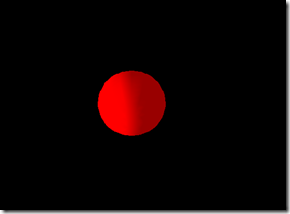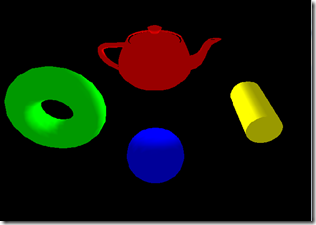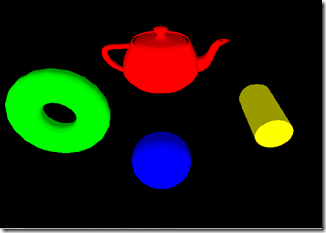为了使渲染出来的东西更加真实, 灯光是必须的。当我们使用灯光的时候我们就可以不用指定顶点的颜色。
1. 灯光的组成
(1) Ambient Light(环境光): 场景中所有的物体的表面会反射这种光源。
(2)Diffuse light(漫射光):当其碰到一个物体时,用各个方向反射。因为满反射的光会朝着物体的各个方向
反射, 所以会到达一个场中的任何地方。 因此,使用diffuse light的时候
我们只需考虑光源发射的方向和物体表面的材质就好了。 这种光是我们用到的
主要光源。
(3)Specular light(镜面反射):在某一特定的方向上传播,当遇到物体时,从一个方向反射。
Specular 反射要求更多的计算。所以在Direct3D中,它是默认关闭的,
如果要打开它Device->SetRenderState(D3DRS_SPECULARENARLE, true)
2. Material(材质)
在真实世界中, 如果一个物体它显示为红色, 是因为它反射的是红色(除了红色以外的全部被吸收了)。
在Direct3D中, 其原理也是一样的。材质反映了其表面对光反射的程度。在 D3D中, 用D3DMATERIAL9表示。
 代码
代码
1 typedef struct _D3DMATERIAL9 {
2 D3DCOLORVALUE Diffuse; /* Diffuse color RGBA */
3 D3DCOLORVALUE Ambient; /* Ambient color RGB */
4 D3DCOLORVALUE Specular; /* Specular 'shininess' */
5 D3DCOLORVALUE Emissive; /* Emissive color RGB */
6 float Power; /* Sharpness if specular highlight */
7 } D3DMATERIAL9;
比如, 如果我们要得到一个红色的球,我们只需定义这个球反射红色就可
 代码
代码
1 D3DMATERIAL9 InitMtrlRed()
2 {
3 D3DMATERIAL9 red;
4 ::ZeroMemory(&red, sizeof(red));
5 red.Diffuse = D3DXCOLOR(1.0f, 0.0f, 0.0f, 1.0f);
6 red.Ambient = D3DXCOLOR(1.0f, 0.0f, 0.0f, 1.0f);
7 red.Specular = D3DXCOLOR(1.0f, 0.0f, 0.0f, 1.0f);
8 red.Emissive = D3DXCOLOR(0.0f, 0.0f, 0.0f, 1.0f);
9 red.Power = 5.0f;
10 return red;
11 }
要画一个球体,另外几处重要的相关代码如下:
 代码
代码
1 ID3DXMesh* sphere = 0;
2 D3DMATERIAL9 mtrlRed;
3 D3DXMATRIX world;
4 bool Setup()
5 {
6 D3DXCreateSphere(Device, 1.0f, 20, 20, &sphere, 0);
7 mtrlRed = InitMtrlRed();
8 D3DXMatrixTranslation(&world, 0.0f, 0.0f, 0.0f);
9 return true;
10 }
11
12 void display()
13 {
14 Device->SetMaterial(&mtrlRed);
15 Device->SetTransform(D3DTS_WORLD, &world);
16 sphere->DrawSubset(0);
17 }
得到如下图:
3. Light Sources(光源的种类)
Direct3D支持3种不同类型的光源。
(1). Point lights(点光源)--》在世界坐标系中的一点,然后向其四周发射。
(2). Directional lights(直射光)--》光源沿着直线传播。
(3). Spot lights(局部照明的光)--》和手电筒相似。
在D3D中, 灯光用D3DLIGHT9结构体表示。
下面列出3个例子来表示3中不用的光源:
(1). point lights
 代码
代码
1 D3DLIGHT9 d3d::InitPointLight(D3DXVECTOR3* position, D3DXCOLOR* color)
2 {
3 D3DLIGHT9 light;
4 ::ZeroMemory(&light, sizeof(light));
5 light.Type = D3DLIGHT_POINT;
6 light.Ambient = *color * 0.6f;
7 light.Diffuse = *color;
8 light.Specular = *color * 0.6f;
9 light.Position = *position;//光源的原始位置
10 light.Range = 1000.0f;//光源的传播范围
11 light.Falloff = 1.0f;
12 light.Attenuation0 = 1.0f;//随着光的传播,其被减弱的程度
13 light.Attenuation1 = 0.0f;
14 light.Attenuation2 = 0.0f;
15 return light;
16 }
(2). Directional lights
 代码
代码
1 D3DLIGHT9 d3d::InitDirectionalLight(D3DXVECTOR3* direction, D3DXCOLOR* color)
2 {
3 D3DLIGHT9 light;
4 ::ZeroMemory(&light, sizeof(light));
5 light.Type = D3DLIGHT_DIRECTIONAL;//光源的种类
6 light.Ambient = *color * 0.6f;//光源发出的环境光
7 light.Diffuse = *color; //光源发出的漫射光
8 light.Specular = *color * 0.6f;//光源发出的镜面反射光
9 light.Direction = *direction;//光传播的方向
10 return light;
11 }
(3)Spot lights
 代码
代码
1 D3DLIGHT9 d3d::InitSpotLight(D3DXVECTOR3* position, D3DXVECTOR3* direction, D3DXCOLOR* color)
2 {
3 D3DLIGHT9 light;
4 ::ZeroMemory(&light, sizeof(light));
5 light.Type = D3DLIGHT_SPOT;
6 light.Ambient = *color * 0.0f;
7 light.Diffuse = *color;
8 light.Specular = *color * 0.6f;
9 light.Position = *position;
10 light.Direction = *direction;
11 light.Range = 1000.0f;
12 light.Falloff = 1.0f;
13 light.Attenuation0 = 1.0f;
14 light.Attenuation1 = 0.0f;
15 light.Attenuation2 = 0.0f;
16 light.Theta = 0.4f;//spot light 装用, 内部的圆锥弧度
17 light.Phi = 0.9f;//spot light 装用, 外部的圆锥弧度
18 return light;
19 }



